|
Passive
Cooling Basics |
| The Energy Source Builder newsletter
http://www.oikos.com/esb/51/passivecooling.html
|
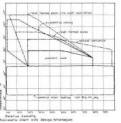 A
very good article that provides a simple method to allow you to determine
which passive cooling techniques are best for your climate. A
very good article that provides a simple method to allow you to determine
which passive cooling techniques are best for your climate.This article
is based on the book "Sun, Wind and Light" (see below). |
|
Be Cool -- Natural Systems to Beat
the Heat,
Preethi Burkholder with Claire Anderson
-- Home Power issue 108
Cooling Your Home Efficiently,
Claire Anderson -- Home Power issue 154.
How to
get articles from Home Power ...
|
 Home
Power magazine article in issue 108 (Aug/Sept 2005) Home
Power magazine article in issue 108 (Aug/Sept 2005)Very good article on
simple techniques to prevent heat gain and to provide passive cooling.
It includes a method to determine which cooling techniques will work best
for your climate.
See also "Cooling Your Home Efficiently", Claire Anderson -- Home Power issue 154.
|
Design a Home
That Keeps You Cool, Naturally,
William Hoffman, Fine Homebuilding August 2004
How to get
articles from Fine Homebuilding ... |
 A
home that illustrates how a number of simple cooling techniques that were
combined in this house to avoid the need for air conditioning in this south
Florida climate. A
home that illustrates how a number of simple cooling techniques that were
combined in this house to avoid the need for air conditioning in this south
Florida climate. |
Passive Cooling -- Part 1 and 2
Cliff Mossberg
How to
get articles from Home Power ... |
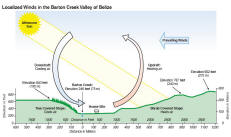 Home Power magazine article, issue 82 and 83 Home Power magazine article, issue 82 and 83Article
on passive design cooling techniques for hot humid climates with examples.
Many techniques covered. |
Lakeland, Florida -- Side by Side
Test,
Florida Solar Energy CenterComparison of energy of a home designed with
many energy efficiency features to a same size conventional construction
home.
http://www.fsec.ucf.edu
|
 This
is a very detailed and carefully done study of two houses of the same size
in Lakeland Florida. One house was built conventionally, and the other
was equipped with a wide array of features to reduce energy consumption,
including: reflective roof, internal duct system, thermal mass inside
insulation, high efficiency and properly sized AC, well designed
overhangs, and optimal windows. This
is a very detailed and carefully done study of two houses of the same size
in Lakeland Florida. One house was built conventionally, and the other
was equipped with a wide array of features to reduce energy consumption,
including: reflective roof, internal duct system, thermal mass inside
insulation, high efficiency and properly sized AC, well designed
overhangs, and optimal windows.
The measured energy consumption was 70% less on the house with low energy
use features. A solar PV system offset and additional 22%, bringing
the net energy use to near zero.
The reports provide quite a bit of detail on the saving achieved by each
energy efficient design feature. |
|
Passive Solar Cooled House in Tropical Areas
http://kotaronishiki.com/
|
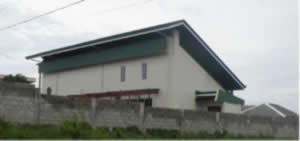 This is a fascinating house in Leyte Philippines that is passively cooled using a number of unique methods including a double roof, a strategy for shading south and north walls in low latitudes using the roof, and double walls on the east and west for shading. This is a fascinating house in Leyte Philippines that is passively cooled using a number of unique methods including a double roof, a strategy for shading south and north walls in low latitudes using the roof, and double walls on the east and west for shading.
The house also uses day to night temperature differences and basement cooled air as part of the cooling strategy.
This house is definitely worth taking a look at if you live in a low latitude hot climate.
|
| Arizona Solar Center -- Passive
Cooling
www.azsolarcenter.com/technology/pas-3.html
|
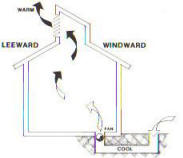 A
good overview of passive cooling strategies. A
good overview of passive cooling strategies. |
| Passive Cooling for Your North
Carolina Home North Carolina Solar Center
NC Passive Cooling
Guide (pdf)
|
 Good
guide to passive cooling houses in the SE humid and warm climates. Good
guide to passive cooling houses in the SE humid and warm climates.From
the NC Solar Center
|
| Landscaping for Energy Efficiency
South Carolina Energy Office
Landscaping for Energy Efficiency (pdf) |
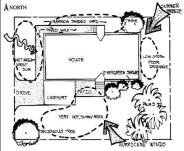 Booklet on landscaping for energy efficiency.
"Carefully positioned trees can save up to 25% of household's energy
consumption". Booklet on landscaping for energy efficiency.
"Carefully positioned trees can save up to 25% of household's energy
consumption".Several other energy saving "briefs" also available here. |
| Window Overhang Sizing Tool Sustainable By Design Solar Tools
http://www.susdesign.com/tools.php
|
 Properly
sized overhangs on south windows keep you cool in the summer and collect sun
in the winter. Properly
sized overhangs on south windows keep you cool in the summer and collect sun
in the winter. |
| Designing Shading Overhangs with
Google SketchUp
http://www.sketchup.com/
Be sure to pick a location near you, or enter your latitude/longitude --
otherwise, sun motions and shadows will not be correct.
|
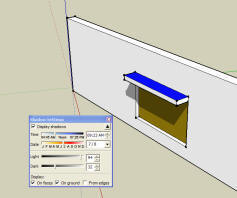 SketchUp
is a free 3D drawing tool from Google. In addition to be exceptionally
easy to use as a general purpose drawing tool, it offers a shadows made by a
built in sun. You can easily draw a wall with a window and overhang,
and play the sun over it for various times of day and times of year. SketchUp
is a free 3D drawing tool from Google. In addition to be exceptionally
easy to use as a general purpose drawing tool, it offers a shadows made by a
built in sun. You can easily draw a wall with a window and overhang,
and play the sun over it for various times of day and times of year.
It could also be used to layout your whole house (with trees and sunspaces),
and see how the sun plays over it.
VERY easy to learn. |
| Sun, Wind and Light --
Architectural Design Strategies, 2nd Edition G. Z. Brown and Mark DeKay |
 Details
on a large number of specific design
strategies for making effective use of the sun and wind, and natural
lighting. It includes quantitative analysis techniques for each strategy.
Intended for architects, but quite readable. Covers commercial
buildings as well as residences.
2001 400 pages |
Radiant Barriers,
SouthFace.org -- Energy Fact Sheet
www.southface.org Radiant Barrier Fact Sheet
|
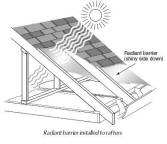 A
short but good Fact Sheet on radiant barriers from SouthFace.org. A
short but good Fact Sheet on radiant barriers from SouthFace.org. |
Climate Consultant,
UCLA Energy Design Tools
http://www.energy-design-tools.aud.ucla.edu/
Note: the psychrometric charts that this tool produces have an overlay
indicating which type of cooling techniques will work well in your climate.
A really nice tool. |
 Climate
Consultant is one of the UCLA Energy Design Tools. Climate
Consultant is one of the UCLA Energy Design Tools.
It provides a variety of ways to visualize weather for a specific location.
Weather data files are available for hundreds of locations. This is a
brand new version, and is very easy to use.
"It graphically displays climate data in either metric or imperial units in
dozens of ways useful to architects including monthly bar charts, timetable
charts, and psychrometric charts, sun shading charts, and sun dial charts."
One of the most interesting charts is the Psychrometric chart
with overlays that show the design strategies (e.g. passive solar,
evaporative cooling, ..) will work for the location in question.
|
Radiant Barrier Pilot Project,
Florida Solar Energy Center,
D. Parker, J. Sherwin, and M. Anello
http://www.fsec.ucf.edu
|
 An
FSEC evaluation of the energy saving for radiant barriers. Nine
houses were monitored for attic temperatures and AC energy use before and
after installing a radiant barrier. An
FSEC evaluation of the energy saving for radiant barriers. Nine
houses were monitored for attic temperatures and AC energy use before and
after installing a radiant barrier.
Bottom line was an about 10% reduction in AC energy costs, and a somewhat
improved comfort level. |
|
Shading Structures |
Window (and house) Shading
How to keep cooler, save money, and be green
all at the same time
Window Shading Techniques
Gary |
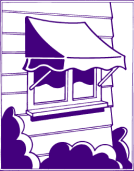 As
much as half the heat gain to your house can come from unshaded windows.
The sunny day heat gain from a hundred square feet of east or west facing window is
the equivalent of running your furnace for several hours. As
much as half the heat gain to your house can come from unshaded windows.
The sunny day heat gain from a hundred square feet of east or west facing window is
the equivalent of running your furnace for several hours.
This is my 2 cents worth on several effective and (mostly) inexpensive ways
to shade your windows and cut down on house overheating, high AC bills, and
greenhouse gas emissions. |
| Sun Screens
The screen material from Phifer:
http://www.phifer.com/ExtSunControl.aspx
And another -- there are lots of
them:
http://www.ezsnapdirect.com/
Exterior window shades -- search for shades:
A similar screening from
Real goods |
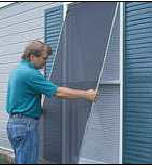 This
seems like a pretty good idea for reducing summer heat gain on windows.
The shades block up to 90% of sunlight, and mount in vinyl frames (like bug
screens). It looks like they would work on a wide variety of windows,
including ones that would be difficult to handle with other shading
techniques. They do the shading on the outside, where its most effect. This
seems like a pretty good idea for reducing summer heat gain on windows.
The shades block up to 90% of sunlight, and mount in vinyl frames (like bug
screens). It looks like they would work on a wide variety of windows,
including ones that would be difficult to handle with other shading
techniques. They do the shading on the outside, where its most effect.
It seems like a DIY version could be worked out. The Phifer SunTex
material is said to be available at some home centers. Frames could
probably be made from the same material that home centers sell for making
insect screens. |
| Exterior Roll Up
See Through Shades
Details... |
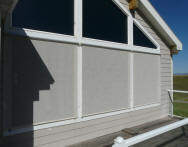 These
are exterior shades that roll down to to provide filtered shade, but still
allow a view out. These
are exterior shades that roll down to to provide filtered shade, but still
allow a view out.We have these, and like them.
Details... |
| My Neighbor's
Outstanding Trellis All the details ... |
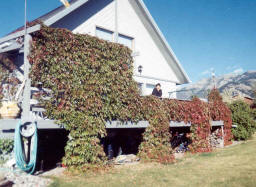 My
neighbor has a terrific trellis with vines shading structure. It makes
for a great shady place to sit on hot sunny summer days. In the
winter with the leaves gone, it provides filtered sun and some solar gain to
the window area behind. My
neighbor has a terrific trellis with vines shading structure. It makes
for a great shady place to sit on hot sunny summer days. In the
winter with the leaves gone, it provides filtered sun and some solar gain to
the window area behind.
And, it provides beautiful fall color.
All the details ... |
| Alnet DIY Rollup Shade Cloth Shades
www.shade-cloth-diy.com/patio-enclosures/patio-enclosures.shtml (no longer exists)
This site has bit the dust -- but, the Wayback Machine still has the project...
|
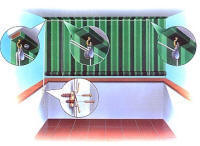 Plans
for a simple rollup shade from shade cloth. Plans
for a simple rollup shade from shade cloth. |
| Trellis Cooling Pictures of the
trellis and other passive cooling features here:
www.inhabitat.com/2005/12/23/ecohouse-brazil/
|
 ECO
house in Rio de Janero uses an aluminum trellis to support plants that will
shade the house wall from from sun. ECO
house in Rio de Janero uses an aluminum trellis to support plants that will
shade the house wall from from sun. |
| Living Wall System
http://www.eltlivingwalls.com
|
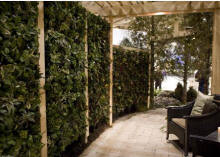 In
addition to all the "green" benefits that these living walls
provide, it seems like they could be very useful for reducing heat gain from
walls that get a lot of sun. In
addition to all the "green" benefits that these living walls
provide, it seems like they could be very useful for reducing heat gain from
walls that get a lot of sun.Lots of example photos and some "hot to" information at this website. |
| Trellis Shading
DoItYourSelf.com Trellis Projects
|
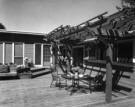 Some
sample projects/pictures that use an external trellis for shading.
This approach works well on East and West facing windows where overhangs are
not effective. Some
sample projects/pictures that use an external trellis for shading.
This approach works well on East and West facing windows where overhangs are
not effective. |
| Shading Structures
from 2007 Solar Decathlon
A little more on the German entry:
www.inhabitat.com/...
Quite a few Solar Decathlon pictures from Inhabitat:
www.flickr.com/photos/inhabitat/1636531291/
|
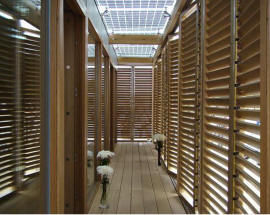 
German entry in the 2007 Solar Decathlon had a nice porch/shading
structure. Note the roof of porch is PV modules.
Note that this would even work on east and west exposures.
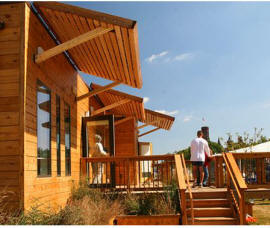 And,
this nice overhang on the Urbana-Champaign entry. And,
this nice overhang on the Urbana-Champaign entry.
Click pictures to enlarge.
Pictures from
Inhabitat |
| Unique Bamboo
Shading Structure Shades Full House
http://inhabitat.com/...
|
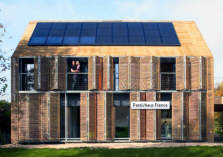 A
home in France built to Passive House Standards uses a very unique shading
structure that shades the full south wall of the house with movable bamboo
shutters. A
home in France built to Passive House Standards uses a very unique shading
structure that shades the full south wall of the house with movable bamboo
shutters. |
| Some Trellis or
Plant Screen Ideas ... |
These are some shading trellis or plant screen ideas excerpted from a
discussion on the HomeEnergySolutions Yahoo discussion group
Thanks to the folks at HomeEnergySolutions for the good ideas!! |
| The Green Shutter
www.inhabitat.com/2006/03/08/green-shutter/
|
 A
pretty neat design for a operable shutter with plants for sun control. A
pretty neat design for a operable shutter with plants for sun control. |
| Schiavello Vertical Garden From Inhabitat:
http://www.inhabitat.com ...
|
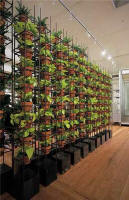 This
design seems as though it might work well for blocking unwanted solar gain
on windows (particularly on difficult to shade east and west facing
windows). This
design seems as though it might work well for blocking unwanted solar gain
on windows (particularly on difficult to shade east and west facing
windows).
For this purpose, it would best be installed outside the window on the
ground or on a balcony.
Judging from the comments, it might be good to think about some type of
watering system. |
| Alnet DIY Awning Plans
www.shade-cloth-diy.com/awnings/awnings.shtml (no longer exists)
The above site is gone, but the Wayback Machine still has the project...
|
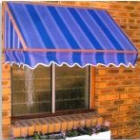 Plans
for a simple wood framed, shade cloth awning to provide window shade and
reduce heat gain. Plans
for a simple wood framed, shade cloth awning to provide window shade and
reduce heat gain.
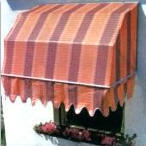 Retractable
version Retractable
version
|
| Alnet DIY Pergola Plans
www.shade-cloth-diy.com/pergolas/pergolas.shtml (no l onger exists)
The above site is gone, but the Wayback Machine still has the project...
|
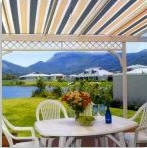 Plans
for a simple wood framed, shade cloth pergola from Alnet. Plans
for a simple wood framed, shade cloth pergola from Alnet. |
| Alnet DIY Trellis
www.shade-cloth-diy.com/garden-designs/garden-designs.shtml (no longer exists)
The above site is gone, but the Wayback Machine still has the project...
|
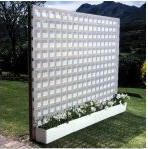 Plans
for a simple wood framed, shade cloth trellis fro Alnet Plans
for a simple wood framed, shade cloth trellis fro Alnet |
| Elegant Shade Structure Popular
Mechanics
www.popularmechanics.com (Pop Mech has dropped this article
but, its still available on the Wayback Machine...
|
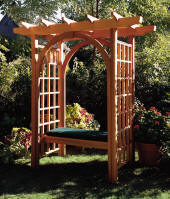 Plans
for a very elegant shade structure. This could be used as a standalone
shade structure or adapted to shade a house window. Plans
for a very elegant shade structure. This could be used as a standalone
shade structure or adapted to shade a house window.Very detailed plans. |
| Windsor Shade shelter California
Redwood Association plans...
|
 Detailed
plans for a free standing shading structure. Detailed
plans for a free standing shading structure.Could be used for yard/deck
shade, or to shade a window. |
| Rollup shade plans
From Charlie's Green House
www.CharliesGreenhouse.com
The Plans (pdf)
|
 Plans
for a simple rollup shade from Charlie's Greenhouse in Seattle. Plans
for a simple rollup shade from Charlie's Greenhouse in Seattle. |
Solar Deck Canopy -- How Well Does It Let Light Through During Winter?
Amy Heidner, PE, 2012 |
 This
is a very interesting paper demonstrating the use of PV panels as part of a
shade canopy that provides shade for living space that was overheating and
generates solar electricity as well. This
is a very interesting paper demonstrating the use of PV panels as part of a
shade canopy that provides shade for living space that was overheating and
generates solar electricity as well.
The aim of the project was to provide sufficient shading to keep the living
area behind the canopy from overheating, while at the same time not
providing so much shade that the the deck and living area would be too
dark.
The authors found that by selecting a PV module design that lets some light
through and adding some glazed areas above and below the PV modules that
they could get just the right light levels under the canopy. |
| Shade
Sails ,,, |
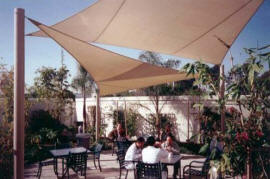 Shade
Sails (or Solar Sails) are fabric membranes supported by fixed anchors, and
positioned to provide shade. They are laid out and tensioned in
such a way as to be very resistant to winds. Shade
Sails (or Solar Sails) are fabric membranes supported by fixed anchors, and
positioned to provide shade. They are laid out and tensioned in
such a way as to be very resistant to winds.They can be used to shade
decks, porches, play areas, windows, ...
They can be very nice looking indeed, and can handle some difficult
shading problems.
Example photos, and design
information here ... |
|
Reflective Roofs |
Comparative
Summer Attic Thermal Performance of Six Roof Constructions,
Danny Parker and John Sherwin,
Florida Solar Energy Center, 1998
The full paper ...
|
 This
is an excellent paper that compares the attic temperatures for 6 different
roof constructions. This
is an excellent paper that compares the attic temperatures for 6 different
roof constructions.
Following the findings of this study can have a major impact on
your cooling costs.
If you don't have time to read the full paper, here is my
quick summary of the findings... |
| Cool Metal Roofing
www.wbdg.org/resources/coolmetalroofing.php
|
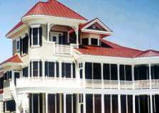 Reflective
metal roofing can keep your house cooler and save on cooling bills. Reflective
metal roofing can keep your house cooler and save on cooling bills.
|
Measured Cooling Energy Savings From
Reflective Roofing Systems In Florida:
Field And Laboratory Research Results,
Parker, Barkaszi, Chandra, and Beal
Florida Solar Energy Center
www.fsec.ucf.edu/en/publications/html/fsec-cr-1220-00/
Measured and Simulated Performance of Reflective Roofing Systems in
Residential Buildings,
Parker, Huang, Konopacki, Gartland, Sherwin, and Gu.
www.fsec.ucf.edu/en/publications/html/fsec-pf-331-98/
A sampling of commercial sources ... |
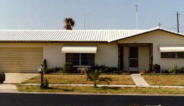 Actual
measurements of reduction in cooling energy for 8 homes in Florida before
and after coating the roof with a reflective (white) coating. Actual
measurements of reduction in cooling energy for 8 homes in Florida before
and after coating the roof with a reflective (white) coating.
Cooling energy savings averaged 20% just by going to a more reflective
roof.
The papers cover both roofing materials that are reflective as well as
coatings that can be applied on existing roofs.
The paper on Roofing Material Reflectivity is good and surprising. |
| "CoolWall" Paint
http://www.texcote.com/coolwall.php
ORNL Report... (pdf)
The flip side of this is that if you live in a cold climate, painting
your home with a dark shade will result in a saving in heating energy. |
 "CoolWall"
paint reduces cooling costs by formulating the paint to be reflective in the
IR, but any color you like in the visible spectrum. In other words,
you can get the same sort of cooling benefit that comes from painting your
house white without having to have a white house. "CoolWall"
paint reduces cooling costs by formulating the paint to be reflective in the
IR, but any color you like in the visible spectrum. In other words,
you can get the same sort of cooling benefit that comes from painting your
house white without having to have a white house.
While many of the "save energy with paint" schemes are scams, this one has
been tested extensively by he ORNL (see links), and does result in a 4 to
21% reduction in cooling energy.
It should not be used in cold climates in that the same high reflectance in
the IR that reduces cooling energy use increases heating energy use.
For example, in Richmond VA, the reduction in summer cooling energy is more
than offset by the increase in winter heating energy.
In the ORNL testing, white paint outperforms the IR reflective cool wall
colors -- so, white paint is good for hot climates. |
|
David's
White Roof Experiment ... |
 David
painted his roof white to measure the amount of cooling that the reflective
roof brought to his attic and living area. David
painted his roof white to measure the amount of cooling that the reflective
roof brought to his attic and living area.
White roof paint experiment ...
From one of the comments on this David's roof:
"...all houses in traditional villages on Greek islands have white roofs. And they use lime, just like you."
|
| Wolfgang's Cool White Roof... |
 This is another roof made hightly reflective using hydrated lime to coat an existing roof. This is another roof made hightly reflective using hydrated lime to coat an existing roof.
The coating is very reflective, and while it does not last forever, it does last longer than you might think.
Wolfgang has kept track of attic temperature and AC use and reports significant savings.
|
|
Applying a White Coating to a Rubber Roof...
|
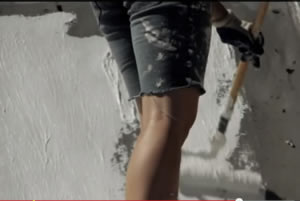 A nice diy package of instructions for applying a reflective white coating to a black tar roof. A nice diy package of instructions for applying a reflective white coating to a black tar roof.
A great passive way to provide significant building cooling.
They have some advice on what paint to use here...
|
|
Monitored Summer Peak Attic Air Temperatures in Florida Residences,
Danny Parker and John Sherwin, FSEC
|
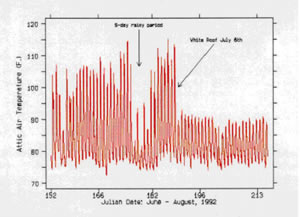 The paper provides measured attic temperatures in the summer in Florida for various types of roof construction. The paper provides measured attic temperatures in the summer in Florida for various types of roof construction.
The plot to the left from the paper shows the effect of changing to a white roof about half way through the plot -- pretty dramatic.
The FSEC site is a great resource for cooling ideas for hot humid climates.
|
|
Cooling Towers & Solar Chimneys |
| Ventilation Rates for Solar Chimneys Energy
and Buildings -- 32
www.ecaa.ntu.edu
|
 Paper provides
measured ventilation rates and room temperatures achieved by four solar
chimney designs. Paper provides
measured ventilation rates and room temperatures achieved by four solar
chimney designs. |
Passive Air Conditioning -- Low Energy
Cooling
Tom Elliot
http://www.i4at.org/lib2/aircool.htm
|
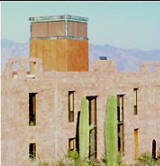 Another writeup on
evaporative cooling towers with some design information. Another writeup on
evaporative cooling towers with some design information. |
| How to Stay Cool in the Hot Desert (with less
power) Charles Van Meter
http://millennium-ark.net
|
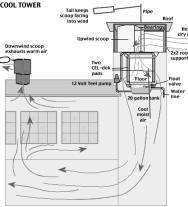 A passive cooling tower
that uses wind and water evaporation for cooling. No blowers -- only
electric demand is a small water pump. A passive cooling tower
that uses wind and water evaporation for cooling. No blowers -- only
electric demand is a small water pump.
Some design rules, and several years operating experience. |
|
Reflectors |
Reflector/Shades,
Steve Baer, Zomeworks Corporation
Reflector Shades paper... pdf
http://www.zomeworks.com/sunbender/
|
 A
good paper by Steve Baer reviewing the use of seasonally moveable reflectors
to increase solar heat gain in the winter, and reduce unwanted heat gain in
the summer. A
good paper by Steve Baer reviewing the use of seasonally moveable reflectors
to increase solar heat gain in the winter, and reduce unwanted heat gain in
the summer.
A nice mix of solar physics and practical how-to that Steve has gained in
the building of many of these types of reflector systems over the years. |
Earth Tubes
Earth tubes are tubes buried in the ground deep enough to
take advantage of the more even year round temperature at depth. Air
from outside the house is run through the earth tubes to heat or cool it
before it is introduced into the house. In the summer, the earth is
cooler that the outside air temperature and the air will be cooled as it
goes through the tubes, and the opposite in the winter. This is a
simple, energy efficient means of pre-heating or pre-cooling air, but there
are a number of things to consider -- so do your homework carefully. |
|
Wikipedia Article on Earth Tube Cooling... |
Pretty good introductory article on earth tube cooling from Wikipedia. |
Performance of Single Pass Earth-Tube Heat
Exchanger: An Experimental Study,
Girja Sharan, Ratan JadhavData from an Earth Tube experiment:
Earth
Tubes2003-01-07GirjaSharan.pdf
|
 An
interesting paper with some actual data on a real earth tube -- this might
be helpful in designing your earth tube. An
interesting paper with some actual data on a real earth tube -- this might
be helpful in designing your earth tube.
The data includes temperatures along the tube, airflows, fan power, and COP. |
Passive Annual Heat Storage,
John Hait, 1983
http://www.earthshelters.com/
|
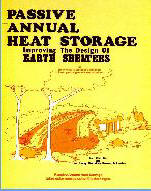 This
book by John Hait is mostly about his Passive Annual Heat Storage home
design, but it does have a section on earth tubes and how they are used on
his houses. This
book by John Hait is mostly about his Passive Annual Heat Storage home
design, but it does have a section on earth tubes and how they are used on
his houses.An interesting all around book. |
| The Natural Home Building on Earthtubing:
http://www.thenaturalhome.com/earthtube.htm
|
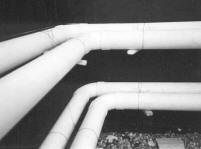 Describes
the way in which earth tubes are used in their house design. Describes
the way in which earth tubes are used in their house design.
They also describe an earth tube system using water rather than air in the
pipes:
http://mb-soft.com/solar/alternwa.htmits hard for me to tell whether
they have actually built one of these or not. |
Analysis, Design, and Prelimnary Testing of Solar chimney for Residential
Air-Conditioning Applications,
Gang Wang, Bing Chen, Mingsheng Liu, Joerg Henkel,
University of Nebraska, Lincoln |
 This
paper looks at the feasibility of using a solar chimney to drive flow
through an earth tube. This
paper looks at the feasibility of using a solar chimney to drive flow
through an earth tube.
Both analysis and testing are provided. |
| REHAU Air - Ground Heat
Exchangers
http://export.rehau.com/ ...
|
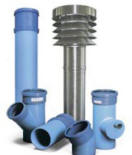 This
company makes components for earth tube heating and cooling systems. This
company makes components for earth tube heating and cooling systems.The
downloadable pdf provides some useful information for designing earth tube
systems.
(thanks to Charles for finding this) |
Ground Temperatures as a Function of Location,
Season, and Depth
Virginia Tech
EarthTemperatures.htm |
 This
material from the
Virginia
Tech website on Geothermal Heat Pumps has some good material on the
variation in ground temperature with depth below the surface, area of the
country, and season. This
material from the
Virginia
Tech website on Geothermal Heat Pumps has some good material on the
variation in ground temperature with depth below the surface, area of the
country, and season. |
| Earth Tube Design
Notes... Gary |
These are just some thoughts on earth tube
design based on nothing more than reading the articles above. |
Efficient
Active
Cooling
-- Ventilation
In some climates, fan forced ventilation and a 24 hour cooling strategy to
reduce heat gain during the day, and make use of cool night air can be very
effective. |
| Whole House Fan for Cooling
Whole House
Fan pdf (240K) |
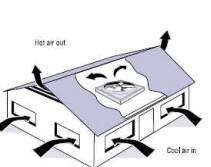 For
relatively dry climates with cool nights, whole house fans are very
effective in reducing or eliminating the need for refrigerated AC. I
have had a whole house fan in my last two houses, and would not be without
one! For
relatively dry climates with cool nights, whole house fans are very
effective in reducing or eliminating the need for refrigerated AC. I
have had a whole house fan in my last two houses, and would not be without
one! |
|
Whole House Fans Tech Sheet (pdf) PG&E
|
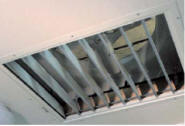 Another
good guide on using and installing a whole house fan. Another
good guide on using and installing a whole house fan. |
| Big Fans
in the Window As Whole House Fan,
Renewable Energy for the Poor Man -- Cheap AC
|
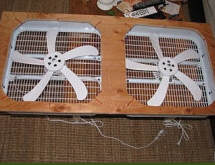 This
is a nice and inexpensive way to get the equivalent of a whole house fan by
using two large fans mounted in a window. This
is a nice and inexpensive way to get the equivalent of a whole house fan by
using two large fans mounted in a window.
This is cheaper, you don't have to cut a hole in the ceiling (and seal it up
for winter), and you can just take it out for the winter.
Flow rates appear to be close that that of a whole house fan. |
| Energy Star Ceiling Fans
www.energystar.gov
Getting the Most from Your Fan,
Chris Calwell and Noah Horowitz
Home Energy
Choosing and Installing a Ceiling Fan,
Fernando Pages Ruiz,
Fine Home Building Magazine
(very good how-to on installing ceiling fans) |
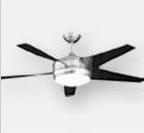 Ceiling
fans are an efficient cooling method for some climates and conditions,
especially when the use of a ceiling fan allows less use of AC. Ceiling
fans are an efficient cooling method for some climates and conditions,
especially when the use of a ceiling fan allows less use of AC.
Energy Star ceiling fans use half as much energy as typical non Energy Star
fans.
Note the directory of approved fans, and the attention to making any light
that might be included with the fan an efficient one.
If you have several ceiling fans in your house, using energy efficient fans
could save you as much as 1000 KWH a year, so its worth finding good ones
and sizing them for the space.
Some thoughts on choosing an efficient ceiling
fan ... |
| Ceiling fans with aerodynamically designed
blades
http://www.fanworks.com/vari-cyclone.htm
|
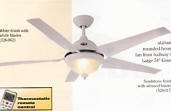 Ceiling
fans with "Gossamer
Wind" technology blades move about 40% more air for the same power use. Ceiling
fans with "Gossamer
Wind" technology blades move about 40% more air for the same power use.
Models are available that operate at 12 or 24V, and can be operated direct
PV or battery.
FSEC paper:
Performance and Applications of Gossamer Windô Solar Powered Ceiling Fans |
Choosing and Installing a Ceiling Fan,
Fernando Pages Ruiz, Fine Homebuilding, Nov 2001 issue 142
How to get articles from Fine Homebuilding .. |
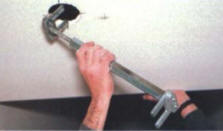 A
Fine Homebuilding article on choosing and installing a ceiling fan.
Lots of detail on mechanical installation for both new construction and
remodel, and detail on how to wire the fan. A
Fine Homebuilding article on choosing and installing a ceiling fan.
Lots of detail on mechanical installation for both new construction and
remodel, and detail on how to wire the fan. |
| Solar
Attic Vent Fan
http://www.arttec.net/Solar/5-21-06/May21-06.html
|
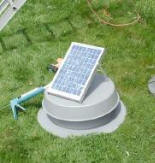 Guy
Marsden describes how to install a solar powered attic vent fan. Guy
Marsden describes how to install a solar powered attic vent fan.
The fan lowers his attic temperature by abut 20 to 30F, which reduces heat
transfer through the ceiling.Adding attic insulation and sealing plumbing
and wiring penetrations through the attic ceiling are other ways to lower
heat transfer from the attic to the living space. |
| Cooling Without
AC Details... |
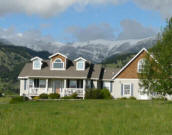 This
is the way we cool our house in SW Montana without using conventional AC. This
is the way we cool our house in SW Montana without using conventional AC.
The strategy involves avoiding daytime heat gains, using cool night air
for thermal mass cooling, and evaporative cooling on a few occasions.
No AC.
Our cooling bills are less than $3 per month!
Details ... |
Night Breeze Cooling System
http://www.davisenergy.com/...
Home Energy Magazine article
Kicking the Air conditioner Habit (pdf)
|
 This
is sort of a highly sophisticated version of a whole house fan. It
eliminates or reduces the need for refrigerated air conditioning by using
cool night air to pre-cool the house for the next hot day. This
is sort of a highly sophisticated version of a whole house fan. It
eliminates or reduces the need for refrigerated air conditioning by using
cool night air to pre-cool the house for the next hot day. |
| Fran's
Use of Subterranean Air to Defeat the Evil Air Conditioner
The whole story... |
 Fran
shows how he used cool air from his basement to defeat the evil air
conditioner. Fran
shows how he used cool air from his basement to defeat the evil air
conditioner.A nice simple
and effective system and a well written story ... |
Efficient
Active
Cooling
-- Evaporative Cooling
In some climates, evaporative (Swamp) coolers can be very effective in both
reducing energy bills and avoiding that crumby, air-conditioned space
feeling. |
| Evaporative Cooling
EERE Evaporative Cooler Basics...
Evaporative Cooling basics from CA Consumer Energy Center...
|
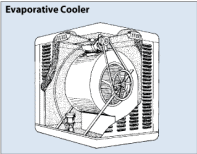 Evaporative
coolers can be very effective and energy efficient in hot climates that do
not have high humidity. The newer indirect models can even be used in
climates with somewhat higher humidity. Evaporative
coolers can be very effective and energy efficient in hot climates that do
not have high humidity. The newer indirect models can even be used in
climates with somewhat higher humidity.
The constant circulation of air avoids the stuffy feel of conventionally air
conditioned spaces. |
|
Mike the Las Vegas Handyman Cuts Annual Power Bill By 60% With A Swamp
Cooler
http://www.pro-handyman.com/...
|
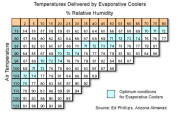 This
is a good article that covers: 1) the kind of savings that can result from a
"swamp" cooler, 2) how to use a swamp cooler optimally, and 3) some good
tips on installing and maintaining one. This
is a good article that covers: 1) the kind of savings that can result from a
"swamp" cooler, 2) how to use a swamp cooler optimally, and 3) some good
tips on installing and maintaining one.
Mike is in Las Vegas and reports a 60% on his annual electric bill since
using a swamp cooler for most of the cooling season over that past couple
years. |
| Cooling Without
AC Details... |
 This
is the way we cool our house in SW Montana without using conventional AC. This
is the way we cool our house in SW Montana without using conventional AC.
The strategy involves avoiding daytime heat gains, using cool night air
for thermal mass cooling, and evaporative cooling on a few occasions.
No AC.
Our cooling bills are less than $3 per month!
Details ... |
| Innovative Design Eliminates
Cooling Equipment Energy Source Builder #36, December 1994.
http://www.oikos.com/esb/36/Inno_Des.html
|
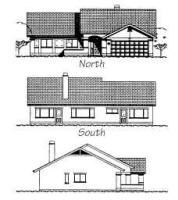 Article
describes a house in Davis, CA (103F summer design temperature) with no
refrigerated air conditioning system. The system uses night time
ventilation and thermal mass to provide cooling. An evaporative cooler
is operated at night to cool thermal mass. Article
describes a house in Davis, CA (103F summer design temperature) with no
refrigerated air conditioning system. The system uses night time
ventilation and thermal mass to provide cooling. An evaporative cooler
is operated at night to cool thermal mass. |
| New Evaporative Cooling Systems --
An Emerging Solution for Homes in Hot Dry Climates with Modest Cooling Loads
Southwest Energy Efficiency Project
Evap Cooler Report (pdf)
Evaporative Cooler Assessment from ToolBase:
http://www.toolbase.org
Two stage evaporative coolers:
www.homeenergy.org ... |
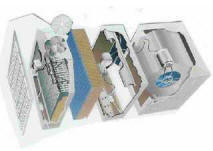 Good
and detailed report on a new generation of evaporative coolers that are more
efficient, use less water, and require less maintenance. Good
and detailed report on a new generation of evaporative coolers that are more
efficient, use less water, and require less maintenance.These cooler in a
relatively dry climate can save 90% compared to compressor driven
conventional air conditioning! |
| PV Powered Evaporative Coolers
http://www.southwest-solar.com/
Some notes on a DIY one:
www.voltscommissar.net/competitive_edge.htm |
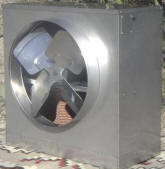 These
evaporative coolers use low HP 12V fans that can be powered by PV arrays. These
evaporative coolers use low HP 12V fans that can be powered by PV arrays. |
|
Night Sky Roof Water Spray Cooling
system
www.ornl.gov/sci/eere/international/Website/WhiteCap.htm
Whitecap roof
cooling system report...
ORNL gov report
While these papers seem to be aimed primarily at commercial applications,
residential applications may well be workable, simple, and energy efficient.
Most beneficial for dry climates. |
 "This
innovation spray-cools water on the roof at night and applies the cooled
water to reduce subsequent cooling loads. On clear nights, the sky is much
colder than outdoor air, contributing to high water cooling rates through a
combination of evaporation and sky radiation. Overnight, NightSky systems
can typically cool a large storage volume (preferably two gallons per square "This
innovation spray-cools water on the roof at night and applies the cooled
water to reduce subsequent cooling loads. On clear nights, the sky is much
colder than outdoor air, contributing to high water cooling rates through a
combination of evaporation and sky radiation. Overnight, NightSky systems
can typically cool a large storage volume (preferably two gallons per square
foot of roof surface) to a final temperature as much as 12 degrees below the
minimum night air temperature."Seems like a very promising way to reduce
the energy cost of cooling. The 5600 sqft prototype described in the
first link achieved an EER of 149. |
| Some Information on Designing and
Building Evaporative Pad Cooling System Ohio State University Fact Sheet
http://ohioline.osu.edu/aex-fact/0127.html
|
 Information
for designing and making your own evaporative pad cooling systems. Information
for designing and making your own evaporative pad cooling systems.I have
seen systems of this type in greenhouses for cooling. |
Plans for Evaporative Coolers
Info on several evaporative cooler schemes for greenhouses
www.gothicarchgreenhouses.com/...
The Paper (pdf)
www.ag.ndsu.nodak.edu/abeng/plans/6208.pdf
|
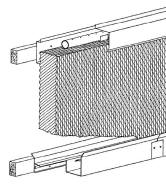 Detailed
plans for making evaporative coolers. Detailed
plans for making evaporative coolers.
Intended for greenhouses, but may be adaptable to other situations. |
Small, DIY, portable, solar powered evaporative
coolers
http://robotfun.wordpress.com/2011/12/21/swampcooler/ |
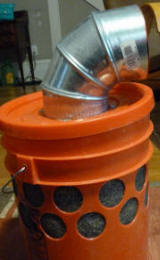 This
is a pretty slick homemade evaporative cooler. This one was made for
camping, but it could be used in a variety of situations. This
is a pretty slick homemade evaporative cooler. This one was made for
camping, but it could be used in a variety of situations.
It can be solar powered, so its also good for saving energy and for power
outages.
Christin provides nice detailed instructions as well as links to other small
and larger DIY evaporative coolers.
(Thanks to BeGreen at the Hearth.com forum for
suggesting this) |
|
A Simple $20 Ice Based Cooler ...
|
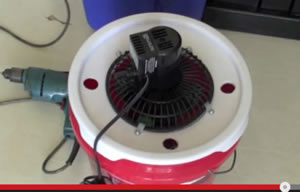 This is a pretty clever and simple cooler for cooling a small space (like a homemade electric car that does not have AC). This is a pretty clever and simple cooler for cooling a small space (like a homemade electric car that does not have AC).
Total cost is a 12 volt DC can and a bucket -- can't get much simpler than that.
Basically, the fan blows air over the ice or water frozen in pop bottles in the bucket.
Have look around Michael's How To Electric Car site while you are there.
|
| Solar Powered DIY RV Evaporative Cooler... |
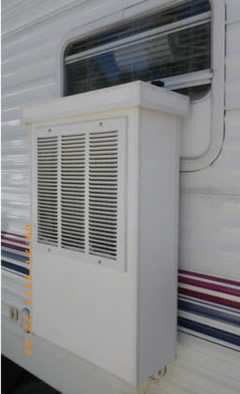 Tom's home made evaporative cooler for his RV. Tom's home made evaporative cooler for his RV.
The system uses fans to blow outside air through a porous wet cooling pad. Evaporation of water in the cooling pad cools the air, dropping the temperature by as much as 25 F.
The compact unit contains a water reservoir, water pump, aspen cooling pad, and circulation fans as shown in the diagram.
It runs on 12 volt DC power and is powered by the RV's solar panel and battery -- pretty cool :)
Tom uses this to cool his RV without having to use grid power, but it could be adapted for all sorts of cooling applications, including emergency cooling when the power grid is down.
|
|
Turbo Kool Evaporative Cooler
http://www.turbokool.com/
Install Manual (pdf) |
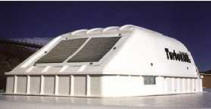 This
is a small 12 VDC evaporative cooler that is intended for RVs, construction
equipment, ... but might work well in any small space. This
is a small 12 VDC evaporative cooler that is intended for RVs, construction
equipment, ... but might work well in any small space.
The fan draws 4 amps, and the company says it will run directly off a 60
watt solar panel. |
Efficient
Active
Cooling
-- More Ways (radiation cooling, hydronic, roof
sprinklers, misters, ...)
|
| Night Radiation Cooling of Water Flowing Over Roof... |
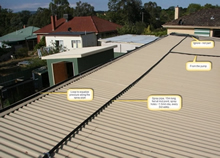 This is David's very efficient space cooling system. At night, the system pumps water from a tank up to a roof spray tube. The water runs down the roof cooling by radiation to the night sky. The water is collected at the bottom of the roof and channeled back to the tank. This is David's very efficient space cooling system. At night, the system pumps water from a tank up to a roof spray tube. The water runs down the roof cooling by radiation to the night sky. The water is collected at the bottom of the roof and channeled back to the tank.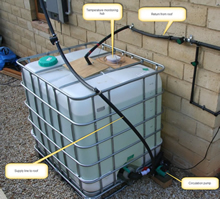
The following day, the cooled water in the tank is used for space cooling.
David is interested in hearing from people on the best way to do the final version of this system.
David provides a very detailed description of hte system and some measure performance.
|
|
Increasing AC Efficiency Using Evaporative Cooling of Condenser Coil
Full details...
|
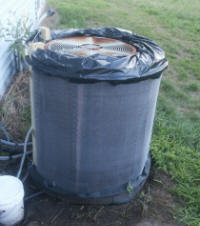 Chad
uses evaporative cooling to reduce the temperature of the air that cools the
condenser coil on his air conditioner. Chad
uses evaporative cooling to reduce the temperature of the air that cools the
condenser coil on his air conditioner.
The AC efficiency is significantly affected by the condenser cooling air
temperature, so this change both increases the AC capacity and also reduces
energy use. This evaporative cooling scheme does not leave mineral
deposits on the condenser coil.
Chad's scheme uses all off the shelf
parts and is fully documented in a 16 page pdf.... |
Theoretical Evaluation of the NightCool Nocturnal Radiation Cooling Concept
Danny S. Parker
Florida Solar Energy Center (FSEC)New report
on the NightCool performance in test buildings:
Experimental Evaluation of the NightCool Nocturnal Radiation Cooling
Concept: Performance Assessment in Scale Test Buildings,
Danny S. Parker, John R. Sherwin
Florida Solar Energy Center (FSEC)
Daily performance of the test buildings,
http://infomonitors.com/ntc/ Note: I would tend to
NightCool in the Experimental area, so, if
you go after this, bear in mind you may suffer the "being a pioneer"
learning curve. Please let us know how it comes out. |
 This
is a simple, building integrated, cooling scheme that uses nighttime
radiation cooling from a metal roof to cool air in the attic space.
Attic air is then circulated into the living area to provide cooling. This
is a simple, building integrated, cooling scheme that uses nighttime
radiation cooling from a metal roof to cool air in the attic space.
Attic air is then circulated into the living area to provide cooling.
A simulation model is used to predict performance in various climates -- the
scheme works very well in dry areas, and fairly well even in very difficult
moist-warm climates (e.g. Florida).
One of the attractive features of this system is that the roof is very
conventional -- no massive ponds or moving insulation.
There is the potential in some climates to use the same metal roofing/attic
system for space heating in colder weather.
The new test report shows the results for two 10' by 16' structures that
were built to compare NightCool performance to conventional AC in Florida.
Very interesting and promising results.
Tests of a a simple dehumidification system using desiccants are now
underway. |
|
Florida Zero Energy Test House Florida Solar Energy Center
The Report (pdf)
|
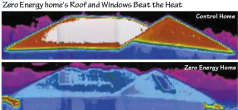 A
home constructed in a very difficult cooling climate (central Florida) to
see if a combination of passive cooling techniques to reduce heat gain, high
efficiency AC, efficient appliances, and a fairly large PV rig could produce
near zero net energy use. The home was largely successful in
meeting these goals. A
home constructed in a very difficult cooling climate (central Florida) to
see if a combination of passive cooling techniques to reduce heat gain, high
efficiency AC, efficient appliances, and a fairly large PV rig could produce
near zero net energy use. The home was largely successful in
meeting these goals.
Net energy use was only about 18% of a control house built to current codes.
Pretty good detail on how much energy each feature saved.
My 2 cents would be that the passive cooling, high efficiency AC, and
efficient appliances contributed 67% the of the savings, while adding little
to the cost of the house. The 4KW PV rig contributed the other 33% of
the savings, and probably cost about $40,000. |
|
Night Air Thermal Mass Cooling Using
Water Barrels
All the details on water barrel space cooling...
|

This is a scheme that I am experimenting with to cool my shop. It
basically blows cool night time air over a collection of 50 gallon barrels
filled with water to store "coolth" in the water.
The method looks like it might provide cooling with a COP of 42 (SEER 140)
or more!
While I am using the scheme in my shop, it could be used to cool any
interior space. The
basic question is: does
it make sense to use a fan forced flow of cool night air over thermal mass
to store "coolth" for later use in daytime cooling?
Details...
|
| Hydronic Cooling
Energy Source Builder, Issue 53
http://www.oikos.com/esb/53/hydroniccool.html
|
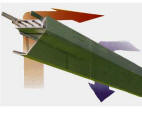 An
article from the Energy Source Builder Newsletter on using hydronic heating
systems for cooling, including radiant floor systems. An
article from the Energy Source Builder Newsletter on using hydronic heating
systems for cooling, including radiant floor systems. |
Roof Sprinkler Cooling System,
JohnFull Details ...
A paper on sizing
commercial roof spray cooling systems... |
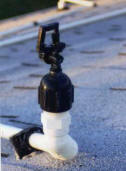 Roof
sprinkler system lowers roof temperature and cooling bills by keeping the
roof cooler through water evaporation. Roof
sprinkler system lowers roof temperature and cooling bills by keeping the
roof cooler through water evaporation.
Added a description of another similar system 3/6/07 |
| Brown Machine Works -- Cool Rain system
http://fp1.antelecom.net/bromac/7.html
|
 This
is a small business that offers a roof sprinkling system to cool attic
areas. They also sell parts to people who want to build their own
system. This
is a small business that offers a roof sprinkling system to cool attic
areas. They also sell parts to people who want to build their own
system.
They have a
detailed installation manual that should be helpful to those building a
system. |
|
Clay Tile Roof Cooling in the Central
Valley... |
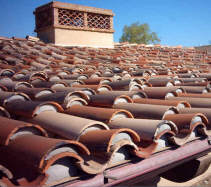 This
is a brief description from David on how
roof sprinkers are used in California's Central Valley for cooling ... This
is a brief description from David on how
roof sprinkers are used in California's Central Valley for cooling ... |
|
Simple Control System for Roof Sprinklers |
Thanks to Curt for sending in this note:
"In this small 1000 sq ft slab and block beach
home, a well pump provided water to a washing machine water valve that was
actuated with a temperature switch from an attic exhaust fan which operated
both the fan and the valve. Connected to the water valve was a soaker hose
like the ones used to water a garden, mounted on the roof's peak. There was
no other cooling system in the house."
Sounds like a nice simple way to do the control system for roof
sprinkler. |
|
Mist Cooling
Misting kit for cooling outdoor areas...
|
 DripWorks.com
sells a misting kit that provides mist cooling for about 25 lineal feet (3
misters). Said to be easy to hook up. DripWorks.com
sells a misting kit that provides mist cooling for about 25 lineal feet (3
misters). Said to be easy to hook up.Mist cooling can be very
effective and comfortable if done well.
I've ordered the kit and will report on how it does.
It looks like water usage is about 3/4 gallon per hour per mister outlet. |
|
Mist Cooling For Large Outdoor Areas |
 A
very simple mist cooler for large outdoor areas. Intended for cows,
but I don't think they will mind if you use their idea. A
very simple mist cooler for large outdoor areas. Intended for cows,
but I don't think they will mind if you use their idea. |
|
Using Your Lawn Sprinkling Water to Cool the House
|
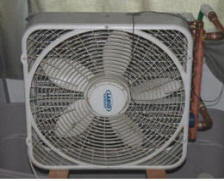 Rick
uses a water to air heat exchanger to extract some "coolth" from the water
he is using to water the lawn. Rick
uses a water to air heat exchanger to extract some "coolth" from the water
he is using to water the lawn.
Its basically free cooling.
All the details on Rick's cooling setup... |
| Cooling
Tips |
|
Sleep Genie -- A sleep Compartment with AC
http://www.sunfrost.com/sleep_genie.html From Sunfrost
You might combine the Sleep Genie with the built in bed concept shown in Mother Earth Magazine: Construct a Cozy Build-in Bed, Maxwell
Finding Mother Earth News articles...
|
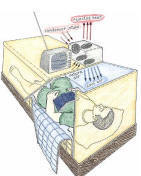 An
interesting concept to provide a comfortable, air-conditioned
environment in a limited space for sleeping comfort. An
interesting concept to provide a comfortable, air-conditioned
environment in a limited space for sleeping comfort.
 It saves the energy cost of needlessly air-conditioning a large space
when your are only occupying a small space. The same idea could be used
for the heating season with a small heater in the bed cubby. |
| Water bed cooling |
 Randy
suggests that in hot climates sleeping directly on the water bed bladder
will be cooler. Randy
suggests that in hot climates sleeping directly on the water bed bladder
will be cooler.
Remove all the coverings except for a sheet or two, and let the water
conduct heat away from your body.
The temperature of the water in the bladder will be the average of the last
few days, and cooler than body temperature.
After more experience, Randy adds that during the cooler season, you want
more insulation (e.g. a blanket) between you and the water bladder to keep
it from getting to chilly. Its a mater of adjusting the amount of
insulation between you and the thermal mass. |


 A
very good article that provides a simple method to allow you to determine
which passive cooling techniques are best for your climate.
A
very good article that provides a simple method to allow you to determine
which passive cooling techniques are best for your climate. Home
Power magazine article in issue 108 (Aug/Sept 2005)
Home
Power magazine article in issue 108 (Aug/Sept 2005) A
home that illustrates how a number of simple cooling techniques that were
combined in this house to avoid the need for air conditioning in this south
Florida climate.
A
home that illustrates how a number of simple cooling techniques that were
combined in this house to avoid the need for air conditioning in this south
Florida climate. Home Power magazine article, issue 82 and 83
Home Power magazine article, issue 82 and 83 This
is a very detailed and carefully done study of two houses of the same size
in Lakeland Florida. One house was built conventionally, and the other
was equipped with a wide array of features to reduce energy consumption,
including: reflective roof, internal duct system, thermal mass inside
insulation, high efficiency and properly sized AC, well designed
overhangs, and optimal windows.
This
is a very detailed and carefully done study of two houses of the same size
in Lakeland Florida. One house was built conventionally, and the other
was equipped with a wide array of features to reduce energy consumption,
including: reflective roof, internal duct system, thermal mass inside
insulation, high efficiency and properly sized AC, well designed
overhangs, and optimal windows.  This is a fascinating house in Leyte Philippines that is passively cooled using a number of unique methods including a double roof, a strategy for shading south and north walls in low latitudes using the roof, and double walls on the east and west for shading.
This is a fascinating house in Leyte Philippines that is passively cooled using a number of unique methods including a double roof, a strategy for shading south and north walls in low latitudes using the roof, and double walls on the east and west for shading.  A
good overview of passive cooling strategies.
A
good overview of passive cooling strategies. Good
guide to passive cooling houses in the SE humid and warm climates.
Good
guide to passive cooling houses in the SE humid and warm climates. Booklet on landscaping for energy efficiency.
"Carefully positioned trees can save up to 25% of household's energy
consumption".
Booklet on landscaping for energy efficiency.
"Carefully positioned trees can save up to 25% of household's energy
consumption". Properly
sized overhangs on south windows keep you cool in the summer and collect sun
in the winter.
Properly
sized overhangs on south windows keep you cool in the summer and collect sun
in the winter.  SketchUp
is a free 3D drawing tool from Google. In addition to be exceptionally
easy to use as a general purpose drawing tool, it offers a shadows made by a
built in sun. You can easily draw a wall with a window and overhang,
and play the sun over it for various times of day and times of year.
SketchUp
is a free 3D drawing tool from Google. In addition to be exceptionally
easy to use as a general purpose drawing tool, it offers a shadows made by a
built in sun. You can easily draw a wall with a window and overhang,
and play the sun over it for various times of day and times of year.

 A
short but good Fact Sheet on radiant barriers from SouthFace.org.
A
short but good Fact Sheet on radiant barriers from SouthFace.org. Climate
Consultant is one of the UCLA Energy Design Tools.
Climate
Consultant is one of the UCLA Energy Design Tools. An
FSEC evaluation of the energy saving for radiant barriers. Nine
houses were monitored for attic temperatures and AC energy use before and
after installing a radiant barrier.
An
FSEC evaluation of the energy saving for radiant barriers. Nine
houses were monitored for attic temperatures and AC energy use before and
after installing a radiant barrier. As
much as half the heat gain to your house can come from unshaded windows.
The sunny day heat gain from a hundred square feet of east or west facing window is
the equivalent of running your furnace for several hours.
As
much as half the heat gain to your house can come from unshaded windows.
The sunny day heat gain from a hundred square feet of east or west facing window is
the equivalent of running your furnace for several hours. This
seems like a pretty good idea for reducing summer heat gain on windows.
The shades block up to 90% of sunlight, and mount in vinyl frames (like bug
screens). It looks like they would work on a wide variety of windows,
including ones that would be difficult to handle with other shading
techniques. They do the shading on the outside, where its most effect.
This
seems like a pretty good idea for reducing summer heat gain on windows.
The shades block up to 90% of sunlight, and mount in vinyl frames (like bug
screens). It looks like they would work on a wide variety of windows,
including ones that would be difficult to handle with other shading
techniques. They do the shading on the outside, where its most effect.
 These
are exterior shades that roll down to to provide filtered shade, but still
allow a view out.
These
are exterior shades that roll down to to provide filtered shade, but still
allow a view out. My
neighbor has a terrific trellis with vines shading structure. It makes
for a great shady place to sit on hot sunny summer days. In the
winter with the leaves gone, it provides filtered sun and some solar gain to
the window area behind.
My
neighbor has a terrific trellis with vines shading structure. It makes
for a great shady place to sit on hot sunny summer days. In the
winter with the leaves gone, it provides filtered sun and some solar gain to
the window area behind. Plans
for a simple rollup shade from shade cloth.
Plans
for a simple rollup shade from shade cloth. ECO
house in Rio de Janero uses an aluminum trellis to support plants that will
shade the house wall from from sun.
ECO
house in Rio de Janero uses an aluminum trellis to support plants that will
shade the house wall from from sun. In
addition to all the "green" benefits that these living walls
provide, it seems like they could be very useful for reducing heat gain from
walls that get a lot of sun.
In
addition to all the "green" benefits that these living walls
provide, it seems like they could be very useful for reducing heat gain from
walls that get a lot of sun. Some
sample projects/pictures that use an external trellis for shading.
This approach works well on East and West facing windows where overhangs are
not effective.
Some
sample projects/pictures that use an external trellis for shading.
This approach works well on East and West facing windows where overhangs are
not effective.


 A
home in France built to Passive House Standards uses a very unique shading
structure that shades the full south wall of the house with movable bamboo
shutters.
A
home in France built to Passive House Standards uses a very unique shading
structure that shades the full south wall of the house with movable bamboo
shutters. A
pretty neat design for a operable shutter with plants for sun control.
A
pretty neat design for a operable shutter with plants for sun control. This
design seems as though it might work well for blocking unwanted solar gain
on windows (particularly on difficult to shade east and west facing
windows).
This
design seems as though it might work well for blocking unwanted solar gain
on windows (particularly on difficult to shade east and west facing
windows). Plans
for a simple wood framed, shade cloth awning to provide window shade and
reduce heat gain.
Plans
for a simple wood framed, shade cloth awning to provide window shade and
reduce heat gain. Retractable
version
Retractable
version Plans
for a simple wood framed, shade cloth pergola from Alnet.
Plans
for a simple wood framed, shade cloth pergola from Alnet. Plans
for a simple wood framed, shade cloth trellis fro Alnet
Plans
for a simple wood framed, shade cloth trellis fro Alnet Plans
for a very elegant shade structure. This could be used as a standalone
shade structure or adapted to shade a house window.
Plans
for a very elegant shade structure. This could be used as a standalone
shade structure or adapted to shade a house window. Detailed
plans for a free standing shading structure.
Detailed
plans for a free standing shading structure. Plans
for a simple rollup shade from Charlie's Greenhouse in Seattle.
Plans
for a simple rollup shade from Charlie's Greenhouse in Seattle. This
is a very interesting paper demonstrating the use of PV panels as part of a
shade canopy that provides shade for living space that was overheating and
generates solar electricity as well.
This
is a very interesting paper demonstrating the use of PV panels as part of a
shade canopy that provides shade for living space that was overheating and
generates solar electricity as well. Shade
Sails (or Solar Sails) are fabric membranes supported by fixed anchors, and
positioned to provide shade. They are laid out and tensioned in
such a way as to be very resistant to winds.
Shade
Sails (or Solar Sails) are fabric membranes supported by fixed anchors, and
positioned to provide shade. They are laid out and tensioned in
such a way as to be very resistant to winds. This
is an excellent paper that compares the attic temperatures for 6 different
roof constructions.
This
is an excellent paper that compares the attic temperatures for 6 different
roof constructions.  Reflective
metal roofing can keep your house cooler and save on cooling bills.
Reflective
metal roofing can keep your house cooler and save on cooling bills. Actual
measurements of reduction in cooling energy for 8 homes in Florida before
and after coating the roof with a reflective (white) coating.
Actual
measurements of reduction in cooling energy for 8 homes in Florida before
and after coating the roof with a reflective (white) coating.
 "CoolWall"
paint reduces cooling costs by formulating the paint to be reflective in the
IR, but any color you like in the visible spectrum. In other words,
you can get the same sort of cooling benefit that comes from painting your
house white without having to have a white house.
"CoolWall"
paint reduces cooling costs by formulating the paint to be reflective in the
IR, but any color you like in the visible spectrum. In other words,
you can get the same sort of cooling benefit that comes from painting your
house white without having to have a white house. David
painted his roof white to measure the amount of cooling that the reflective
roof brought to his attic and living area.
David
painted his roof white to measure the amount of cooling that the reflective
roof brought to his attic and living area. This is another roof made hightly reflective using hydrated lime to coat an existing roof.
This is another roof made hightly reflective using hydrated lime to coat an existing roof. A nice diy package of instructions for applying a reflective white coating to a black tar roof.
A nice diy package of instructions for applying a reflective white coating to a black tar roof. The paper provides measured attic temperatures in the summer in Florida for various types of roof construction.
The paper provides measured attic temperatures in the summer in Florida for various types of roof construction. Paper provides
measured ventilation rates and room temperatures achieved by four solar
chimney designs.
Paper provides
measured ventilation rates and room temperatures achieved by four solar
chimney designs. Another writeup on
evaporative cooling towers with some design information.
Another writeup on
evaporative cooling towers with some design information. A passive cooling tower
that uses wind and water evaporation for cooling. No blowers -- only
electric demand is a small water pump.
A passive cooling tower
that uses wind and water evaporation for cooling. No blowers -- only
electric demand is a small water pump. A
good paper by Steve Baer reviewing the use of seasonally moveable reflectors
to increase solar heat gain in the winter, and reduce unwanted heat gain in
the summer.
A
good paper by Steve Baer reviewing the use of seasonally moveable reflectors
to increase solar heat gain in the winter, and reduce unwanted heat gain in
the summer. An
interesting paper with some actual data on a real earth tube -- this might
be helpful in designing your earth tube.
An
interesting paper with some actual data on a real earth tube -- this might
be helpful in designing your earth tube. This
book by John Hait is mostly about his Passive Annual Heat Storage home
design, but it does have a section on earth tubes and how they are used on
his houses.
This
book by John Hait is mostly about his Passive Annual Heat Storage home
design, but it does have a section on earth tubes and how they are used on
his houses. Describes
the way in which earth tubes are used in their house design.
Describes
the way in which earth tubes are used in their house design. This
paper looks at the feasibility of using a solar chimney to drive flow
through an earth tube.
This
paper looks at the feasibility of using a solar chimney to drive flow
through an earth tube. This
company makes components for earth tube heating and cooling systems.
This
company makes components for earth tube heating and cooling systems. This
material from the
This
material from the
 For
relatively dry climates with cool nights, whole house fans are very
effective in reducing or eliminating the need for refrigerated AC. I
have had a whole house fan in my last two houses, and would not be without
one!
For
relatively dry climates with cool nights, whole house fans are very
effective in reducing or eliminating the need for refrigerated AC. I
have had a whole house fan in my last two houses, and would not be without
one! Another
good guide on using and installing a whole house fan.
Another
good guide on using and installing a whole house fan. This
is a nice and inexpensive way to get the equivalent of a whole house fan by
using two large fans mounted in a window.
This
is a nice and inexpensive way to get the equivalent of a whole house fan by
using two large fans mounted in a window. Ceiling
fans are an efficient cooling method for some climates and conditions,
especially when the use of a ceiling fan allows less use of AC.
Ceiling
fans are an efficient cooling method for some climates and conditions,
especially when the use of a ceiling fan allows less use of AC.  Ceiling
fans with "Gossamer
Wind" technology blades move about 40% more air for the same power use.
Ceiling
fans with "Gossamer
Wind" technology blades move about 40% more air for the same power use. A
Fine Homebuilding article on choosing and installing a ceiling fan.
Lots of detail on mechanical installation for both new construction and
remodel, and detail on how to wire the fan.
A
Fine Homebuilding article on choosing and installing a ceiling fan.
Lots of detail on mechanical installation for both new construction and
remodel, and detail on how to wire the fan. Guy
Marsden describes how to install a solar powered attic vent fan.
Guy
Marsden describes how to install a solar powered attic vent fan.  This
is the way we cool our house in SW Montana without using conventional AC.
This
is the way we cool our house in SW Montana without using conventional AC.
 This
is sort of a highly sophisticated version of a whole house fan. It
eliminates or reduces the need for refrigerated air conditioning by using
cool night air to pre-cool the house for the next hot day.
This
is sort of a highly sophisticated version of a whole house fan. It
eliminates or reduces the need for refrigerated air conditioning by using
cool night air to pre-cool the house for the next hot day. Fran
shows how he used cool air from his basement to defeat the evil air
conditioner.
Fran
shows how he used cool air from his basement to defeat the evil air
conditioner. Evaporative
coolers can be very effective and energy efficient in hot climates that do
not have high humidity. The newer indirect models can even be used in
climates with somewhat higher humidity.
Evaporative
coolers can be very effective and energy efficient in hot climates that do
not have high humidity. The newer indirect models can even be used in
climates with somewhat higher humidity. This
is a good article that covers: 1) the kind of savings that can result from a
"swamp" cooler, 2) how to use a swamp cooler optimally, and 3) some good
tips on installing and maintaining one.
This
is a good article that covers: 1) the kind of savings that can result from a
"swamp" cooler, 2) how to use a swamp cooler optimally, and 3) some good
tips on installing and maintaining one. Article
describes a house in Davis, CA (103F summer design temperature) with no
refrigerated air conditioning system. The system uses night time
ventilation and thermal mass to provide cooling. An evaporative cooler
is operated at night to cool thermal mass.
Article
describes a house in Davis, CA (103F summer design temperature) with no
refrigerated air conditioning system. The system uses night time
ventilation and thermal mass to provide cooling. An evaporative cooler
is operated at night to cool thermal mass. Good
and detailed report on a new generation of evaporative coolers that are more
efficient, use less water, and require less maintenance.
Good
and detailed report on a new generation of evaporative coolers that are more
efficient, use less water, and require less maintenance. These
evaporative coolers use low HP 12V fans that can be powered by PV arrays.
These
evaporative coolers use low HP 12V fans that can be powered by PV arrays. "This
innovation spray-cools water on the roof at night and applies the cooled
water to reduce subsequent cooling loads. On clear nights, the sky is much
colder than outdoor air, contributing to high water cooling rates through a
combination of evaporation and sky radiation. Overnight, NightSky systems
can typically cool a large storage volume (preferably two gallons per square
"This
innovation spray-cools water on the roof at night and applies the cooled
water to reduce subsequent cooling loads. On clear nights, the sky is much
colder than outdoor air, contributing to high water cooling rates through a
combination of evaporation and sky radiation. Overnight, NightSky systems
can typically cool a large storage volume (preferably two gallons per square Information
for designing and making your own evaporative pad cooling systems.
Information
for designing and making your own evaporative pad cooling systems. Detailed
plans for making evaporative coolers.
Detailed
plans for making evaporative coolers.  This
is a pretty slick homemade evaporative cooler. This one was made for
camping, but it could be used in a variety of situations.
This
is a pretty slick homemade evaporative cooler. This one was made for
camping, but it could be used in a variety of situations. This is a pretty clever and simple cooler for cooling a small space (like a homemade electric car that does not have AC).
This is a pretty clever and simple cooler for cooling a small space (like a homemade electric car that does not have AC). Tom's home made evaporative cooler for his RV.
Tom's home made evaporative cooler for his RV. This
is a small 12 VDC evaporative cooler that is intended for RVs, construction
equipment, ... but might work well in any small space.
This
is a small 12 VDC evaporative cooler that is intended for RVs, construction
equipment, ... but might work well in any small space.  This is David's very efficient space cooling system. At night, the system pumps water from a tank up to a roof spray tube. The water runs down the roof cooling by radiation to the night sky. The water is collected at the bottom of the roof and channeled back to the tank.
This is David's very efficient space cooling system. At night, the system pumps water from a tank up to a roof spray tube. The water runs down the roof cooling by radiation to the night sky. The water is collected at the bottom of the roof and channeled back to the tank.
 This
is a simple, building integrated, cooling scheme that uses nighttime
radiation cooling from a metal roof to cool air in the attic space.
Attic air is then circulated into the living area to provide cooling.
This
is a simple, building integrated, cooling scheme that uses nighttime
radiation cooling from a metal roof to cool air in the attic space.
Attic air is then circulated into the living area to provide cooling. A
home constructed in a very difficult cooling climate (central Florida) to
see if a combination of passive cooling techniques to reduce heat gain, high
efficiency AC, efficient appliances, and a fairly large PV rig could produce
near zero net energy use. The home was largely successful in
meeting these goals.
A
home constructed in a very difficult cooling climate (central Florida) to
see if a combination of passive cooling techniques to reduce heat gain, high
efficiency AC, efficient appliances, and a fairly large PV rig could produce
near zero net energy use. The home was largely successful in
meeting these goals.
 An
article from the Energy Source Builder Newsletter on using hydronic heating
systems for cooling, including radiant floor systems.
An
article from the Energy Source Builder Newsletter on using hydronic heating
systems for cooling, including radiant floor systems. Roof
sprinkler system lowers roof temperature and cooling bills by keeping the
roof cooler through water evaporation.
Roof
sprinkler system lowers roof temperature and cooling bills by keeping the
roof cooler through water evaporation. This
is a small business that offers a roof sprinkling system to cool attic
areas. They also sell parts to people who want to build their own
system.
This
is a small business that offers a roof sprinkling system to cool attic
areas. They also sell parts to people who want to build their own
system.
 This
is a brief description from David on how
This
is a brief description from David on how
 A
very simple mist cooler for large outdoor areas. Intended for cows,
but I don't think they will mind if you use their idea.
A
very simple mist cooler for large outdoor areas. Intended for cows,
but I don't think they will mind if you use their idea.
 An
interesting concept to provide a comfortable, air-conditioned
environment in a limited space for sleeping comfort.
An
interesting concept to provide a comfortable, air-conditioned
environment in a limited space for sleeping comfort.

 Randy
suggests that in hot climates sleeping directly on the water bed bladder
will be cooler.
Randy
suggests that in hot climates sleeping directly on the water bed bladder
will be cooler.